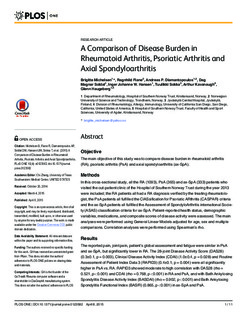| dc.contributor.author | Michelsen, Brigitte | |
| dc.contributor.author | Fiane, Ragnhild | |
| dc.contributor.author | Diamantopoulos, Andreas P | |
| dc.contributor.author | Soldal, Dag | |
| dc.contributor.author | Hansen, Inger Johanne Widding | |
| dc.contributor.author | Sokka, Tuulikki | |
| dc.contributor.author | Kavanaugh, Arthur | |
| dc.contributor.author | Haugeberg, Glenn | |
| dc.date.accessioned | 2015-11-25T08:14:21Z | |
| dc.date.accessioned | 2016-01-13T10:18:42Z | |
| dc.date.available | 2015-11-25T08:14:21Z | |
| dc.date.available | 2016-01-13T10:18:42Z | |
| dc.date.issued | 2015 | |
| dc.identifier.citation | PLoS ONE 2015, 10(4) | nb_NO |
| dc.identifier.issn | 1932-6203 | |
| dc.identifier.uri | http://hdl.handle.net/11250/2373584 | |
| dc.description.abstract | Objective:
The main objective of this study was to compare disease burden in rheumatoid arthritis (RA), psoriatic arthritis (PsA) and axial spondyloarthritis (ax-SpA).
Methods:
In this cross-sectional study, all the RA (1093), PsA (365) and ax-SpA (333) patients who visited the out-patient clinic of the Hospital of Southern Norway Trust during the year 2013 were included; the RA patients all had a RA diagnosis verified by the treating rheumatologist, the PsA patients all fulfilled the ClASsification for Psoriatic ARthritis (CASPAR) criteria and the ax-SpA patients all fulfilled the Assessment of SpondyloArthritis international Society (ASAS) classification criteria for ax-SpA. Patient-reported health status, demographic variables, medications, and composite scores of disease activity were assessed. The main analyses were performed using General Linear Models adjusted for age, sex and multiple comparisons. Correlation analyses were performed using Spearman’s rho.
Results:
The reported pain, joint pain, patient’s global assessment and fatigue were similar in PsA and ax-SpA, but significantly lower in RA. The 28-joint Disease Activity Score (DAS28) (0.3±0.1, p = 0.003), Clinical Disease Activity Index (CDAI) (1.0±0.4, p = 0.028) and Routine Assessment of Patient Index Data 3 (RAPID3) (0.4±0.1, p = 0.004) were all significantly higher in PsA vs. RA. RAPID3 showed moderate to high correlation with DAS28 (rho = 0.521, p<0.001) and CDAI (rho = 0.768, p<0.001) in RA and PsA, and with Bath Ankylosing Spondylitis Disease Activity Index (BASDAI) (rho = 0.902, p<0.001) and Bath Ankylosing Spondylitis Functional Index (BASFI) (0.865, p<0.001) in ax-SpA and PsA.
Conclusion:
In conclusion, patient- reported outcome measures were similar in our population of PsA and ax-SpA patients, but significantly lower for the RA patients. Composite disease activity measures were lower in RA than in PsA and ax-SpA, but the magnitude of these differences was small and probably not of clinical significance. Our study indicates that disease burden in RA, PsA and ax-SpA may be more similar than previously demonstrated. | nb_NO |
| dc.language.iso | eng | nb_NO |
| dc.publisher | Public Library of Science | nb_NO |
| dc.title | A comparison of disease burden in rheumatoid arthritis, psoriatic arthritis and axial spondyloarthritis | nb_NO |
| dc.type | Journal article | nb_NO |
| dc.type | Peer reviewed | |
| dc.date.updated | 2015-11-25T08:14:21Z | |
| dc.source.pagenumber | 4 | nb_NO |
| dc.source.journal | PLoS ONE | nb_NO |
| dc.source.issue | 10 | nb_NO |
| dc.identifier.doi | 10.1371/journal.pone.0123582 | |
| dc.identifier.cristin | 1251806 | |
| dc.description.localcode | This is an open access article, free of all copyright, and may be freely reproduced, distributed, transmitted, modified, built upon, or otherwise used by anyone for any lawful purpose. The work is made available under the Creative Commons CC0 public domain dedication. | nb_NO |
